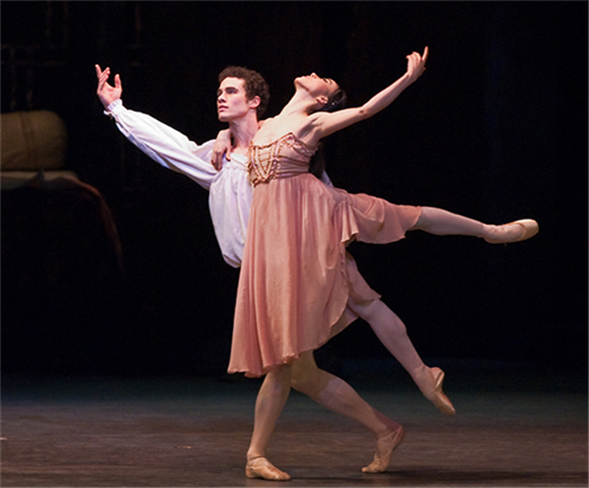Translate Page

Welcome to Building Character, our ongoing look at performers and how they create their roles
Cory Stearns has played Romeo, Prospero, Oberon, and Iago---all without ever speaking a line.
A tall, elegant principal dancer with American Ballet Theatre, Stearns has portrayed these major Shakespearean characters in ballets based on the Bard. Among his extensive repertory are the leading roles in four works---three celebrated classics, and one created just last year---that in very different ways attempt to bring Shakespeare's characters and dramas to life through movement alone.
Next week, as part of its eight-week season at the Met, ABT presents four performances (June 30 – July 2) of its Shakespeare Celebration program, a double bill of ballets based on A Midsummer Night's Dream and The Tempest. Both are substantial one acts, condensing their source plays in very different ways. Both are also set to incidental music that major classical composers created for productions of the original dramas.
The Dream, an acknowledged masterwork by Frederick Ashton, the leading British ballet choreographer of the 20th century, is set to Mendelssohn's well-known score. It captures the sylvan atmosphere, human folly, and mischievous magic of the Bard's celebrated comedy with most of the major characters represented. Now 50 years old---but eternally fresh---it was created for The Royal Ballet, but has found a welcome home (and multiple fine interpreters of its challenging roles) at ABT.
{Image2}
The Tempest, meanwhile, was created last year by Alexei Ratmansky, one of the most admired and prolific classical choreographers working today. The music is Jean Sibelius' expansive 1925 score, composed for a Danish production. Ratmansky, who excels in creating vivid dramatic ballets as well as bracing abstract works, describes the piece as "at once a fragmented narrative as well as a meditation on some of the themes of Shakespeare's play."
Stearns worked closely with Ratmansky as the ballet took shape for its premiere last October. (He and Marcelo Gomes alternate as Prospero). Although he had tackled Romeo and other demanding Shakespearean roles, The Tempest was the first for which he was present at the creation. And being asked to portray an older character---one with a very specific backstory, and complex motivations ---provided plenty of challenges.
"Some of the steps in Tempest are ones an older man could never do," says the Long Island native, who joined ABT in 2006. "I definitely had questions about the motivations for some of the steps. I think Ratmansky felt that Prospero was old, but he had this power coursing through him. He tried to show that power through the choreography
Helping to provide answers was theatre director Mark Lamos, who was the dramaturg for Ratmansky's ballet. "If I had a question, I would turn to Mark," Stearns recalls. "He came in later in the process and was like a professor. He would give a general character appraisal about how we should approach Prospero, and then we would have to take it ourselves and try to match that appraisal to the choreography."
He continues, "I remember Mark explaining that this whole ballet is not spontaneous. Prospero is not thinking of ideas as they come. He has this great plan. It's like a chess game: He's making everything happen. It changes the way you dance the steps. You have the idea that there's a purpose for later behind every movement.
"There's a section that Ratmansky choreographed where it appears I'm very angry with Ferdinand. I'm violent with him. I remember it confused me, because I actually want him and Miranda to be together. But I'm testing his mettle. At the beginning, I don't want to make it too easy for them to be together, so I antagonize him."
As research for the role, Stearns watched a filmed London stage performance with Christopher Plummer as Prospero. "That helped tremendously," he says. "It gave me a better idea of just how to walk." Similarly, while rehearsing for Romeo in Kenneth MacMillan's <em>Romeo and Juliet</em>, he studied the 1968 Franco Zeffirelli film and also looked at Baz Luhrmann's offbeat 1996 version. "I will find what's weakest in my own interpretation of the role and that's what I'll do research on. For Romeo, I really needed to find the passion and the youth of the character. I am much more subtle and understated."
When he was tapped to perform "The Moor's friend" (as Iago is identified) in The Moor's Pavane Jose Limón's fascinating, concise synthesis of Othello, Stearns drew on his familiarity with the play, having studied it closely while at The Royal Ballet School during his high school years.
But he's found that while it can be helpful, it's not always required---or even preferable---to have immersed himself in Shakespeare's text. Too much knowledge can be a dangerous thing if the dancer is being asked to perform according to the choreographer's imagination and not necessarily the Bard's original words.
"Sometimes you have pre-formed ideas or character interpretations that you bring to the first rehearsal," Stearns says. "You might think, 'the character is supposed to feel like this,' based on something you read or learned, but not on the actual choreography."
In the case of The Tempest , that choreography has been evolving, Stearns reports. Ratmansky has made some changes in preparing it for next week's performances, which only underscores how the Bard can be an almost inexhaustible inspiration to choreographers.
---
Susan Reiter is a freelance arts journalist who contributes to the Los Angeles Times, Playbill, Dance Magazine and other publications</i>
Photos by John Grigaitis